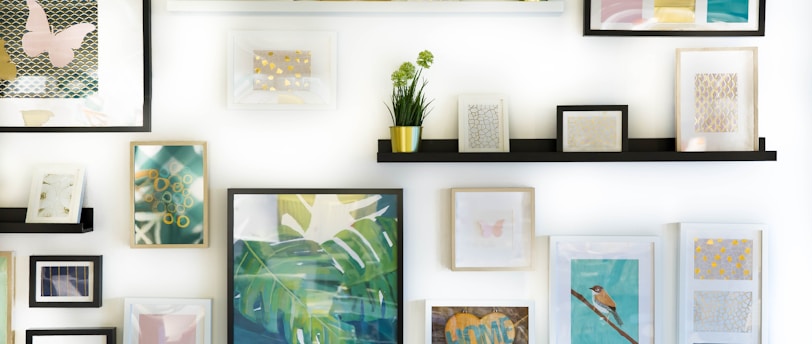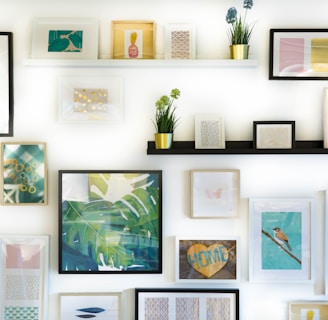Gallery Wall Arrangement Tips: Transform Your Space with Art


Understanding the Basics of Gallery Walls
Gallery walls have become an increasingly popular choice in home decor, serving as a perfect way to showcase personal style and artistic interests. A gallery wall is a curated collection of art pieces, photographs, or other decorative objects arranged on a single wall, creating a visually appealing focal point in any room. By combining various artworks, homeowners can express their personality while transforming a blank wall into an engaging narrative.
One crucial aspect of a successful gallery wall is visual balance. Achieving this balance involves harmonizing the sizes and shapes of your chosen pieces. For example, it may be beneficial to mix large statement pieces with smaller artworks. This combination can prevent the arrangement from feeling lopsided or cluttered. Furthermore, the spacing between each item can also impact the overall aesthetic; allowing for consistent gaps can create a more unified look.
Choosing a theme for your gallery wall is another essential consideration. A well-defined theme can enhance the impact of your display by providing focus. Whether it is a color scheme, subject matter, or stylistic approach, having a cohesive theme helps create a sense of unity among the different pieces. Additionally, understanding the general principles of design—such as contrast, alignment, and repetition—can further guide you in developing an attractive arrangement.
When planning a gallery wall, it’s also wise to consider how the display will interact with the surrounding space. Factors like wall color, furniture placement, and lighting can all influence the visual experience. Ultimately, gallery walls not only elevate your interior design but also cultivate an environment that reflects your unique artistic taste and preferences.
Selecting the Right Artwork and Frames
Creating a gallery wall involves the careful selection of artwork that not only showcases your personal style but also enhances the aesthetic of the room. To begin, consider the emotions you wish to evoke with your collection. Choose pieces that resonate with you personally, whether they are vibrant paintings, serene photographs, or striking prints. These selections should reflect your interests, experiences, and the overall vibe you wish to convey in the space.
When mixing different types of art, balance is key. A well-curated gallery wall often features a combination of mediums, such as paintings, drawings, and photographs. Aim for a diversity that allows each piece to shine while maintaining a cohesive visual story. For instance, you might juxtapose a bold abstract painting with a series of monochrome photographs to create interest. Despite the varied forms, consistency in theme or style aids in achieving a unified look.
The choice of frames is equally crucial. Select frames that not only complement the artwork but also align with the room's decor. Consider using a uniform frame color for a polished appearance, or opt for varied frames to add an eclectic touch. Keep in mind that color schemes play an important role in tying different pieces together; utilizing a palette that echoes the dominant hues in your room will create harmony across the collection. Additionally, accessibility is important—ensure that the artwork is displayed at eye level to enhance visibility, allowing viewers to appreciate each piece fully.
Ultimately, selecting the right artwork and frames involves a thoughtful approach that reflects your individuality while harmonizing with the existing decor. A well-planned gallery wall can significantly elevate the ambiance of any space, creating an engaging and visually appealing focal point within your home.
Layout Techniques for Maximum Impact
Creating a visually striking gallery wall involves careful consideration of layout techniques that enhance both aesthetics and the overall atmosphere of the space. Three popular arrangements—grid, salon-style, and asymmetrical—each offer unique ways to display artwork effectively.
The grid layout is characterized by its orderly, balanced appearance. In this arrangement, artworks are hung in a precise, geometric pattern, often equidistant from one another. This method is ideal for showcasing pieces that share similar framing or thematic elements, creating a cohesive visual impact. To implement a grid layout, begin by measuring the wall space and deciding on the number of artworks to display. Use painter's tape to outline the dimensions on the wall, ensuring that all pieces are symmetrical and evenly spaced.
Alternatively, the salon-style layout shines through its eclectic mix of artworks displayed closely together, creating an intimate gallery feel. This approach permits a diverse array of frames, styles, and sizes. To achieve a salon-style display, start by laying out the individual pieces on the floor to gauge which arrangements resonate visually. Establish a focal point and build around it, considering both alignment and varying gaps between the frames. The aim is to create a balanced yet dynamic composition.
Asymmetrical layouts offer a more contemporary approach, allowing for visual intrigue and spontaneity. With this technique, artworks are arranged without the constraints of symmetry, often focusing on balance through size, color, and form. When creating an asymmetrical gallery wall, consider grouping pieces based on common themes or complementary colors. Utilize a combination of larger and smaller artworks to guide the viewer's eye across the wall's surface.
Regardless of the layout chosen, always measure gaps between pieces to maintain a consistent look while aligning frames to achieve a polished finish. Utilizing these layout techniques, your gallery wall will not only elevate your space but also reflect your personal style and artistic preferences.
Final Touches and Maintenance of Your Gallery Wall
The final touches on your gallery wall can significantly enhance its overall appeal and create a cohesive atmosphere within your space. One effective way to achieve this is through strategic lighting. Proper lighting can accentuate the beauty of your artwork, so consider installing picture lights or spotlights designed for art. Additionally, using soft ambient lighting can make your gallery wall feel more inviting. Variations in light intensity can also create different moods, allowing you to adapt the ambiance according to the occasion.
Incorporating personal items such as mementos or carefully selected quotes can provide a unique character to your gallery wall. These personal touches foster a deeper connection to the art, making the arrangement uniquely yours. Consider integrating small shelves where you can display these items alongside your framed pieces. Alternating between different frame styles, colors, and materials can also add depth and interest to your gallery wall, but it is essential to ensure that the various elements harmonize with each other to maintain a unified look.
As your tastes evolve, you may find it appealing to adjust your gallery wall arrangement. Regularly updating your artwork can keep the display fresh and engaging. This could include replacing older pieces with new acquisitions or rotating artworks based on seasons or occasions. Furthermore, proper care for the artwork and frames is vital. Ensure that you dust frames regularly and keep them out of direct sunlight to prevent fading. For more significant pieces, professional cleaning may be advisable. By maintaining the integrity of both the art and the framing, your gallery wall can remain visually appealing and meaningful for years to come.
